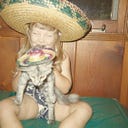Hello Nick - I actually work in the field of startups and expansions, and because there are so few people in my sector who understand anything about tech, I often get AI/ML startups. I wasn't telling you that you are not doing something worthwhile or not working in a valuable area. I was trying to tell you that the work your machine is producing is not art as it is made by humans. There are thousands, and probably millions of factors that go into the making of human art - it isn't about duplicating images: there is something that already does that--it's called a "camera." Art is also not about arranging shapes and colors or putting different textures. There are already a number of programs that do that, ranging from expensive (Adobe) to free (Gimp). I can literally see Photoshop-type filters on these images, "duplicating paint strokes." They all look like mediocre Photoshop art filter results or the output of Adobe pattern-maker (I can't remember the name of it - used it once).
Your machine is making machine art - and to the majority of humans, the end product shows pattern, color and shape, but it's not really forming into a cohesive piece of art. A human artist starting out wouldn't make these images, and it doesn't mean that your machine is "more talented" and will eventually "make better art" it means that you programmed it (correct?) and it's operating under your parameters, so it's missing things that, if it were a human artist in art school, would be told "This lacks a focal point" and in critique group it would be "What are you trying to say here?" People go to art school for a reason - and I went so I know what I'm talking about. And this is my mother: are you telling me your machine can do this?
https://animationobsessive.substack.com/p/when-sterling-sturtevant-perfected?s=r
I am not sure you should aim for making human-like art being the machine's goal anyway. There are many things that machines do better than humans already. But what my mother did isn't one of them, nor is what I do one of them. Because she and I (and you) are humans. The machine IS learning to do something. It may take the role it has in architecture. It may be a good tool to benefit human artists - but what you're doing is very similar to Photoshop filters. You're generating results relating verbal parameters and sets to an initial input such as a phrase like the book covers - or, I saw the landscapes. It's like you've invented a super flexible paint brush that can paint a huge variety of strokes, colors, and shapes on a digital canvas. That is what you have right now, in my opinion. And, maybe the machine has ideas of what it would do on its own. That you don't know yet.
Actually, now that I look at the images again, have you considered attempting to do actual learning in some way? Because from an art perspective, there's something basic wrong with all of them. The book cover ones have no focal point. How do you select that, what would you tell your machine to do? And if it's an off focal point, the image also will be unsatisfactory for the desired result. None of the book cover images could be used for a book cover for a variety of practical reasons. That should be part of the AI or ML, shouldn't it? If I match what I see here to art student progress or education - the problem is that the images are not yet forming cohesive results (yes, including the landscapes). They are "art-like" arrangements of shape, color and texture.
So, in the fundamental sense - the main lack is "Who is the audience" and "What result is the picture trying to achieve?" Right now they are arrangements of color, shape, and texture. In art school, students start with life drawing. Then they progress further. There may be a reason for that.
